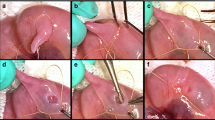Abstract
Neonates with congenital diaphragmatic hernia (CDH) have other malformations that contribute to the high mortality. The nitrofen rat model allows experimental study of these anomalies. This study examines whether the tracheobronchial tree is also abnormal in this model. Time-mated rats received 100 mg nitrofen on gestational day 9.5; 90 fetuses were harvested on day 21 (near full term) and dissected. The trachea and bronchi were stained with alcian blue-alizarin red and their anatomy was examined by transillumination under a microscope. The findings were compared with those of 11 suitable controls. Control pups had no malformations. Those with CDH (n = 57) had significantly decreased numbers of tracheal rings in comparison with controls (22.9 ± 1.9 vs 26 ± 1.9, P < 0.05) and 40/57 had fragmented rings (0 in controls). Twelve CDH animals had, in addition, tracheal stenoses of variable severity, sometimes related to vascular rings. Nitrofen fetuses without CDH (n = 33) had only short tracheas and 4 had mild stenoses. Nitrofen-exposed fetuses have, in addition to lung hypoplasia and sometimes CDH, severe tracheobronchial anomalies that suggest the involvement of pathogenetic mechansims capable of acting on various tissue components. The genetic control of organogenesis is most probably disturbed by the teratogen.
Similar content being viewed by others
Author information
Authors and Affiliations
Rights and permissions
About this article
Cite this article
Xia, H., Migliazza, L., Diez-Pardo, J. et al. The tracheobronchial tree is abnormal in experimental congenital diaphragmatic hernia. Pediatr Surg Int 15, 184–187 (1999). https://doi.org/10.1007/s003830050550
Issue Date:
DOI: https://doi.org/10.1007/s003830050550




